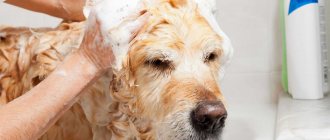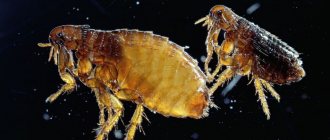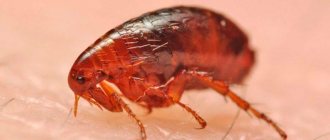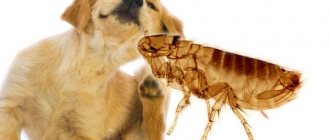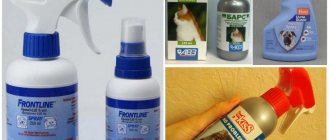How dangerous are bloodsuckers?
Bloodsuckers can cause a number of diseases and complications. To minimize the risk, they need to be eliminated quickly. They should also be feared because:
Bloodsuckers can cause a number of diseases and complications
- they carry a large number of diseases, even fatal cases occur;
- due to the fact that babies do not have enough red blood cells, a large number of insects causes anemia;
- due to the saliva of parasites, allergies appear (itching, redness, other symptoms);
- bites lead to infection or dermatitis;
- blood-sucking insects are carriers of helminths.
Fleas are especially dangerous in a puppy under 1 month of age, since the baby does not yet have the proper immunity. There is a high risk of complications of the disease, sometimes leading to death.
Advertising:
Where do fleas come from in puppies?
No dog is immune to these parasites, and there are many ways a puppy can pick them up. Moreover, the older the animal, the more variants of infection there are. Here are the main ones:
- In newborn puppies, infection from the mother is most likely;
- the puppy, which was handed over to new owners, could still have eggs or larvae of the parasite, which began to multiply and pester the baby more;
- it is quite possible that the first time your pet walks outside, a flea will cling to it;
- if other animals are found in the room with the dog, then there is a chance of infection from them;
- it is possible that the parasites could transfer to the baby from the owner’s clothes or shoes;
Due to these factors, it is necessary to closely monitor the puppy and other pets, periodically checking them for the presence of bloodsuckers, so that if insects are present, treatment can be started in the early stages.
Protection methods
There are several ways to remove fleas from a 1 month old puppy. At home, this is done using special devices (shampoos, drops, collars) or folk methods.
Fleas are especially dangerous in a puppy under 1 month of age, since the baby does not yet have the proper immunity.
The first thing you should pay attention to is the age of the animal. For a one-month-old puppy (up to six weeks), regular bathing is sufficient. The water should be at a suitable temperature - 37-40°C. The animal's fur must be wetted, keeping its head above the water, and then wiped thoroughly (most importantly, gently). Immediately after this, wrap it in a towel and dry it well. Then you need to carefully comb the fur with a special comb. When everything is done, you need to look at your pet's skin and then manually remove any remaining insects.
This happens: the animal experiences itching, but there are no parasites. It turns out that there are a number of factors that cause itching in a small pet. These include:
- stress;
- ectoparasites;
- allergies;
- a number of skin diseases;
- hyperfunction of the sebaceous glands;
- endocrine pathologies;
- reproductive system problems;
- the presence of malignant processes.
Today there are a large number of drugs that can be used to treat young dogs.
It is almost impossible to identify all diseases on your own. Therefore, when you first notice how your animal is constantly itching, you need to seek help from a veterinarian. He will accurately determine the cause of the discomfort.
Symptoms and external signs
The first and main sign that your pet has fleas is its constant scratching. He can also chew his fur. And it is possible to find out whether the puppy was really attacked by parasites only through a detailed examination. You can comb against the grain to check for the presence or absence of bloodsuckers. They usually like to be located behind the ears, as this area has thinner skin and is easier to bite.
Fleas can also be detected during water procedures. Insects will jump off the pet or try to move to drier parts of the body.
Flea saliva causes very strong allergic reactions in babies, so redness will be another symptom. Sometimes it happens that due to the negative effects of parasites, hair loss may occur. Therefore, it is worth closely monitoring changes in the dog’s behavior and appearance.
Read What is the normal temperature in dogs and newborn puppies
Rating of the best drugs
Today there are a large number of drugs that can be used to treat young dogs. However, despite all the diversity, it is quite difficult to remove parasites, so you need to know exactly which remedy is best.
All drugs are divided into several groups:
- shampoos;
- drops;
- sprays;
- solutions (for example, hellebore water);
- collars.
The undisputed leader among shampoos is Beaphar.
The undisputed leader among shampoos is Beaphar. This is confirmed by numerous certificates, as well as the great popularity of the company’s products. Animal shampoo has four levels of action:
- Fight against parasites.
- Preventing re-infection.
- Cleaning areas where an infected puppy has been.
- Deworming.
Shampoo is used once. It is important to avoid contact with the mucous membranes of the eyes, ears or tongue.
Drops are no less effective. This product is applied only to the neck area - where the dog cannot reach with its tongue and paws. This is necessary to prevent the pet from licking the poison. Babies can be given drips from the age of one month. The animal should not get wet for 24 hours after the procedure, so you should not bathe it or walk with it in the rain. To get the best effect, the animal can be treated several times.
Shampoo is used once. It is important to avoid contact with the mucous membranes of the eyes, ears or tongue.
The third option is a special collar for your pet. It is used for the prevention of infection rather than for treatment. You can be sure that there are no fleas if you constantly follow preventive measures. The collar can be used at any age, which is especially suitable for small pets.
The choice of other options is large - drops, solutions, and shampoos. What is the best flea treatment for puppies? The question is controversial. It is advisable to use several options.
The best flea remedies
There is a wide range of flea control products on the market. The main thing is to choose a product according to the puppy’s age and pay attention to its composition. You can rid your puppy of fleas with special shampoos, drops or sprays.
Shampoos
Zoo shampoos for puppies are made from natural ingredients with the addition of insecticides, which kill parasites. The shampoo is gentle on the skin, making it suitable for use on small pets. In just a few baths you can get rid of bloodsuckers, and as a bonus, this product takes care of the baby’s skin and coat. Such drugs are the safest, so there are more of them than drops and sprays. Here are some of them:
- Beaphar is a product from a Dutch company that includes permethrin and is suitable for dogs of any coat length;
- Phytoelite - consists of herbal extract and a small dose of permethrin;
- Celandine - contains essential oils and insecticide.
The shampoo is applied to damp hair, foams and lasts for about 5 minutes. Rinse off the foam well, rinse the wool and dry. As an addition, after this procedure you can comb your pet.
Drops
This drug is best used from the age of two months and if the pet is alone in the house. The product also contains insecticides, which are the active substance against parasites. It is applied to the puppy’s skin, spreading the fur, and to places inaccessible for licking. This procedure does not take much time and provides prevention against infection for a period of one to two months. The safest for puppies:
- Frontline spot - active substance - fipronil, recommended for use for pets over two months old, provided that its weight is more than 2 kg;
- Celandine drops - like shampoo, contain essential oils, but with the addition of fipronil;
There are other names of drops: “Bars Forte”, “Advocate”, “Practician”, which can be used to treat a puppy. Before use, be sure to read the composition and instructions.
Sprays and aerosols
They are good because they are easy to apply, work quickly and are highly effective. The spray kills fleas within a few minutes and protects against re-infestation. Before use, shake, apply to the entire body against the growth of the coat, slightly moisturize it. Processing must be carried out in a well-ventilated area or outdoors.
Read Removing the fifth toe from a puppy and an adult dog: 3 stages
It is better to choose certified sprays and aerosols that have passed quality and safety control. These include:
- Stronghold - contains selamectin, which destroys flea larvae, suitable for puppies over 1.5 months of age;
- Frontline - can be used even for the smallest ones, the number of presses on the spray can depends on the weight and length of the fur (a calculation table is included in the kit);
- Leopard - contains fipronil and protects the puppy for 30 days from all types of blood-sucking insects.
After application, do not allow your pet to lick itself and refrain from water treatments for the next 2 days.
Anti-flea collars
Typically used to prevent parasite infection. The collar is simply put on the pet’s neck and left for several months; it has a fairly long insecticidal effect. But if the puppy has sensitive skin, then it is quite possible that he will have an allergic reaction from wearing such an accessory. Typically suitable for animals over 10 weeks of age. Market leaders:
- HartZ - contains tetrachlorvinphos, which belongs to the third safety class, suitable for 1.5-2 months of age;
- Beaphar - has the same characteristics and active ingredient.
The collar will be effectively used in combination with another product, for example, shampoo.
Traditional methods
If you do not trust radical drugs, there are a large number of folk remedies that allow you to get rid of fleas without harming puppies. Often these are homemade lotions, shampoos or sprays that have a negative effect on insects.
Note: such folk remedies for fleas for small dogs should be made only from fresh ingredients, without an allergic reaction.
Here are a few recipes that can destroy bloodsuckers:
- Herbal decoction. They use wormwood, calamus, tansy, mint, wild rosemary. The herbs are boiled together, or only one of the listed ones is taken. It is important that the broth is strong and warm. We wet the dog's fur, raising his head above the water. Keep for 15 minutes. Afterwards, wipe thoroughly with a towel. Comb out. The product is an excellent substitute for shampoo thanks to the natural ingredients of the decoction.
- Tar soap. The pet must be wet, thoroughly soaped, wrapped in film and then with a towel. Keep it like this for up to 20 minutes. Rinse off the soap, dry the animal with a towel, and comb it out.
These two methods are the most effective. With their help, you will be able to overcome the bloodsuckers without harm to the baby.
Prevention measures are directly determined by where the dog is - in a new family, where he is alone, or together with his relatives.
Symptoms of infection
It is easy to understand that a puppy has fleas long before small black dots are found in his fur - adult parasites and their waste products.
Pet infected with parasites:
- Becomes restless but lethargic.
- Constantly itches, tries to bite into the fur with his teeth.
- Loses appetite.
- Sheds profusely. Hair loss is especially noticeable in the abdomen, groin, area under the paws and in the folds.
- Whines or squeaks pitifully.
On the skin of an animal with fleas, redness and bumps of bites are clearly visible, and on the fur, white grains - parasite eggs - are visible to the naked eye.
Prevention
Prevention measures are directly determined by where the dog is - in a new family, where he is alone, or together with his relatives.
In the first case, fleas should be poisoned using medications. They are also used for prevention. In this case, collars are best suited.
When the pet is with the family, all toxic substances must be excluded. Drugs from the skin of some dogs, when washed by the mother, can get into other babies. This will lead to their poisoning or even death. Therefore, it is necessary to use natural preparations here.
It is best to use the scents of wormwood, mint, lavender, bedbug, sweet clover, tansy or flea beetle. The herbs themselves, their oils or powders should be scattered on the floor of the room where the pets spend the most time. The outer part of the lounger (the one that touches the floor) is impregnated with herbal oils. The strong aroma will repel insects.
It is best to use the scents of wormwood, mint, lavender, bedbug, sweet clover, tansy or flea beetle.
What to do if you find fleas
If you find even one flea on your dog, you need to act as follows.
Life cycle of fleas
- Do not delay treatment - fleas multiply at high speed. It will only take a few days for the pet to stop sleeping and eating, and for the insects to penetrate into all surrounding objects. It will be much more difficult to get them out of there than with a dog. In addition, in this case, there remains a high risk of re-invasion.
- Take a comprehensive approach to eliminating parasites. In addition to the pet, you will have to treat the room in which he lives (in the case of the street, this is an enclosure, a booth, everything that is in them). To ensure that you get rid of bloodsuckers, you will need to use not only folk, but also industrial pest control products.
- The drug for treating your four-legged friend must be selected in accordance with its characteristics, for example, age, attitude to washing, and state of health. Ideally, you should consult a veterinarian, but advice from people who have already encountered such a situation and successfully overcome it is also acceptable.
- During the period of disinfestation measures, the dog must be in “quarantine” - it is worth limiting it from free walking and communication with unfamiliar relatives.
How to protect babies under 1 month from bloodsuckers?
Babies are especially helpless in front of insects. Most flea treatments are not available for puppies under 1 month of age. They are commercially available, but cannot be used at such an early age. During the first 4-5 weeks, a small dog develops its own immunity, and then the work of the immune system begins.
However, how then can you get rid of fleas on a puppy? It is necessary to resort to a folk remedy for fleas - a strong decoction or tar soap. First of all, it is advisable to try decoctions, since they are not so “nuclear” and are easier for the baby to tolerate.
The danger of fleas for puppies
For a young and unformed puppy, a flea bite is more dangerous than for an adult dog. Not only the severe itching, which bothers even older dogs, and even makes a small dog whine, but also a number of other reasons are dangerous for the baby.
- the young pet’s immune system is not yet fully formed, and they are completely defenseless against infectious agents that are transmitted by parasites through a bite;
- the puppy’s skin is still very tender and therefore will suffer more from allergic reactions to flea saliva;
- with severe infection, significant blood loss and anemia may occur;
- worms, which can be contracted from fleas, deplete the dog’s body;
If your pet often itches and bites itself, then you need to carefully examine it, and if parasites are found, immediately begin to remove them. Also, before mating, it would be better to treat the mother of the offspring with a long-acting agent so that she and the future offspring are protected during pregnancy and lactation.
Protection for 2 months
Almost everyone knows how to remove fleas from a 2-month-old puppy. A strengthened body can withstand a number of treatments without any problems, namely shampoos, sprays, drops and collars.
The first product used is chosen to be as soft as possible.
Important: all substances must be as natural as possible. More persistent poisons are allowed from the age of 5 months.
The first product used is chosen to be as soft as possible. It is advisable to start with shampoos and consolidate the results with a collar. You only need to put a flea collar on a dry pet, so there is no need to bathe him beforehand.
However, remember that it is not only the pet that needs to be treated, but also the place where it lives.
Safe use
Before purchasing, read the instructions, make sure that the anti-flea shampoo is suitable for your dog, and there are no contraindications for its use (age, illness, pregnancy, feeding puppies). Use the manufacturer's recommended dosage. If it is exceeded, symptoms of poisoning may appear (nausea, vomiting, stomach upset, skin irritation, impaired coordination of movements, lethargy). But if you reduce the dosage, the flea and tick shampoo will not work. A reduced dose of insecticides will not be lethal to parasites; some of them will survive and continue to reproduce. Do not change the duration of foam application. If you exceed the time recommended by the manufacturer, drying out and skin irritation may occur. If it is reduced, blood-sucking insects will have a chance to survive and continue to parasitize the dog.
Protection for 3 months
Treat animals 3-5 months old. permissible with all arsenal of means. Moreover, it is allowed to use more durable and strong products that will destroy all insects in just one procedure.
You only need to put a flea collar on a dry pet, so there is no need to bathe him beforehand.
When choosing flea treatments for puppies over 2 months of age, pay attention to the indicated age and weight of the pet, ingredients, method of application, and speed of action.
Important: the chosen option must act gently. Rapid action indicates a strong poison that will harm a small animal.
Preventive measures
To prevent your puppy from becoming infected with fleas, take the following preventive measures:
- The place where the pet is kept is kept clean.
- Regularly inspect the animal for pests.
- Contact with street animals is not allowed.
- After returning from the street, shoes are thoroughly washed.
- If necessary, use antiparasitic drugs.
Insectoacaricidal drugs are used in the dosage prescribed by the veterinarian. If symptoms of intoxication appear (vomiting, nausea, excessive drooling, rapid breathing), the puppy is shown to a doctor.
User reviews
Marta, 32 years old: “I was advised to use a collar for my Marsik as a preventive measure. However, for a long time I wondered: “When can I put a flea collar on a small puppy?” The internal struggle in me was resolved by a pharmacist who also has a pet. I’ll be honest, I changed collars several times over the course of a year, but I never regretted my choice.”
Oksana, 28 years old: “With the advent of the little Rottweiler, I was interested in only one question: “Can one-month-old puppies be treated for fleas?” And if so, then with what. I chose the best option - Beaphar shampoo. To be more reliable, I used it twice, and now there are no insects on our baby.”
Advantages and disadvantages
Advantages of anti-flea and tick shampoo:
- contains a lower dose of insecticides than drops, there are foam liquids without synthetic poisons, but with natural repellents to protect weakened animals from parasites;
- easy to use - it is not difficult to train a dog to stand still while bathing;
- can get rid of several types of insects: ticks, gadflies, mosquitoes;
- safe and affordable remedy;
- makes the coat soft, shiny, strengthens it.
But anti-flea shampoo for dogs is not recommended for use as the sole or primary treatment for healthy animals. Its protective properties last for 1-3 weeks. To remove parasites, it is not enough to bathe the dog; you need to sanitize the room and bedding.
Medicines for small breed dogs
This category contains medications that are intended exclusively for small breeds of dogs. These drugs have a small concentration of active substances, which helps to avoid negative consequences.
1
Novartis Prac-tik
894 rub.
We start our review of the best flea drops with Novartis Prac-tik. This drug is approved exclusively for small animals that weigh no more than 4.5 kg. In addition, there is an age restriction: this product is prohibited for puppies under 8 weeks of age. The active component of the drops is pyriprole, which has a pronounced acaricidal and insecticidal effect. With its help you can get rid of fleas, lice and ticks.
9.9 /10
rating
pros
- Affordable price
- No harmful components
- High efficiency
Minuses
Novartis Prac-tik
2
Advantix (Bayer)
RUB 2,618
These drops are the safest for pets. They are suitable for small breed dogs up to 7 weeks old. In this case, the dog’s weight should be between 4 and 10 kg. The drug has a contact-intestinal effect on pests. At the same time, it kills not only adult insects, but also the eggs they lay.
9.7 /10
rating
pros
- Safe composition
- Long validity period
- Suitable for prevention
Minuses
Advantix (Bayer)
3
Lawyer (Bayer)
RUB 1,381
Available in the form of drops, which are approved for use on dogs weighing up to 10 kg. This product is also suitable for puppies, but it can only be used after the pet reaches 7 months of age. The composition of the medicine is not too concentrated, so it is absolutely safe to use it to fight fleas. For the same reason, the drug is approved for pregnant dogs.
9.6 /10
rating
pros
- No harmful substances
- Suitable for puppies
- Easy to apply
Minuses
Lawyer (Bayer)
4
Frontline Combo S
620 rub.
This relatively inexpensive drug has become known for its long duration of action. It quickly kills fleas and protects your dog from their reappearance for 30 days. Combo S is suitable for puppies over 8 weeks old and adult pets whose weight does not exceed 10 kg. The medicine contains fipronil, which has a wide spectrum of action (kills fleas and their offspring).
9.4 /10
rating
pros
- Low price
- Long lasting effect
- Destroys flea eggs
Minuses
Frontline Combo S
How to properly treat a room
Fleas live not only on animals, but also in the kennel, bedding, or even under baseboards in enclosed spaces, so in the fight against them it is very important to treat not only the pet, but also its usual habitat. The minimum action in this case will be vacuum treatment of the bedding and the animal’s habitual resting area, and to prevent parasites from entering the apartment from the entrance, you will have to additionally wipe the threshold, preferably using repellents
Among the main methods of disinsection treatment of premises, the following options are especially popular:
- Thermal impact. When the temperature outside is below zero, sometimes it’s enough just to take the dog’s bed outside for a few hours. The opposite effect would be boiling the litter or steaming it with an iron, which will also negatively affect fleas.
- Use of chemicals. The use of "Karbofos", "Phenaxin", "Reid" or other disinfectants with a similar mechanism of action is appropriate when disinfecting the floor, walls and corners of the room in which the animal is located. They are often used to disinfect upholstered furniture or large interior items, because the main thing is not to leave a single untreated item in the room, otherwise there is a possibility that repeated disinfection will be necessary.
- Traditional methods. From herbal and oily infusions or decoctions, to treat a room against fleas, all the same compounds can be used as when disinfesting the dog itself: wormwood, pine needles, laundry soap and kerosene. The latter is highly effective when used independently, while in all other cases it is advisable to combine traditional and chemical methods of flea control. In the simplest version, you can simply place sprigs of fresh wormwood under the baseboard and in the corners of the room, replacing them with a new part of the plant over the course of a month as they dry out.
- Professional pest control. This option involves the involvement of professional special services in the treatment of the premises, who are involved in eliminating not only fleas, but also other insects. In this case, the essence of the work is to use devices that provide the release of steam particles with the insecticide present in them, which, settling on the surfaces of objects, penetrate into their deep layers and infect insects hiding there. In comparison with previous methods of disinfestation, professional exposure is rightfully considered the most effective solution, but in most cases, people turn to specialists for help only in the most extreme cases.
Home → Useful tips → Treating dogs for fleas and ticks
Everything you need to know about treating dogs for fleas and ticks.
— Why do you need to treat dogs for ticks?
Ticks are carriers of a number of diseases - piroplasmosis, anaplasmosis, ehrlichiosis, theileriosis. In addition, feeding mites cause anxiety to the animal, and a large number of them on small animals can even lead to anemia (anemia).
—At what age can puppies be treated for fleas and ticks?
Treatment is possible from the age of two months. It is very important to treat adult dogs and cats living with a puppy for fleas and ticks.
— Preparations for ticks and fleas in dogs, how to treat your dog?
Frontline, Vectra, Rolf Club, Hartz, Prak-tik - drops on the withers; Bravecto, Nexgard - flea and tick tablets.
—Is it possible to use different tick and flea treatments at the same time on dogs?
(drops, collars, sprays, key chains, tablets)? It is possible to use drops on the withers or tablets together with collars, the active substance should be different.
— How to properly treat a dog for ticks?
Spot-on preparations (drops) are applied behind the ears and down the neck area from above, to those places from which the dog cannot lick them off. The tablets are given orally without food. It is important to apply flea and tick medications based on your pet's weight.
— How to treat a dog for ticks if it weighs less than 2 kg?
Nexgard or Bravecto tablets should not be used in animals weighing less than 2 kg. Such animals should be treated with drops on the withers in a dosage half as much as needed for dogs weighing 2-4 kg, that is, use half a pipette.
— Treating dogs against ticks before vaccination/castration, are there any special features? Surgical interventions leave a negative imprint on the functioning of the animal’s immune system, but do not affect the number of fleas on it, so flea and tick treatments are necessary. It is recommended to do this 10 days before the intended procedure.
—Is it possible to treat a dog with anti-tick medications and anti-worm tablets at the same time?
Yes, you can. Inspector is a complex preparation in the form of drops on the withers, which, when absorbed into the blood, have a destructive effect on both fleas and ticks and helminths. Such drops are more convenient to use, since treating the animal will take less time and there is no need to give deworming tablets. The drug Nexgard Spectrum also works. If you use different drugs, then it would be correct to treat for ticks and for worms on different days.
—How often should you treat your dog for ticks and fleas?
When using drops on the withers - once a month before frost in the fall and start again in the spring, when the snow begins to melt. If your animal communicates with dogs or cats that may have fleas, then treatment does not need to be stopped even in winter. If the animal is washed more than twice a month, it is recommended to reduce the interval between treatments to 3 weeks. Bravecto tablets are given once every 3 months, Nexgard - once a month.
—Flea and tick tablets for dogs, are they safe?
Yes, it's safe. All active ingredients included in the tablets have class 4 toxicity, that is, if the dosage is observed, they do not affect the animal’s internal organs and metabolism. At the same time, carefully read the instructions or consult a veterinarian before taking the tablets, since each active ingredient has its own contraindications.
—If my dog vomits 2 hours after taking a flea and tick tablet, does it need to be re-treated with the drug?
Yes, I need it. But you need to make sure that vomiting was not a side reaction to the pill. To re-treat, you should use drops on the withers, and also examine the dog for stomach or intestinal diseases.
—Is it possible to treat a dog against ticks and fleas with medications for cats?
Not necessary, since the active ingredients and their dosage are different for dogs and cats. Moreover, it is strictly forbidden to treat cats with drops and tablets for dogs, since some of the active ingredients included in their composition can lead to the death of the cat.
—What side effects can there be from anti-tick medications?
There should be no side effects or complications in animals when applying drops to the withers according to the instructions with correct dosage. If there is increased individual sensitivity to the components of the drug and signs of allergic reactions appear, the treatment is stopped, the drug is washed off with water, and antihistamines are given orally. When using tablets, individual sensitivity is possible, manifested by vomiting and diarrhea. If your animal is seriously unwell, you should contact a veterinarian.
—What diseases can a tick bite cause in a dog?
The most common is piroplasmosis. More difficult to diagnose are borreliosis, theileriosis, ehrlichiosis, and anapasmosis. In any case, all these diseases are extremely dangerous for the health of your pet. Therefore, it is much easier to carry out preventive treatments against ticks than to treat these pathologies.
—The dog was bitten by a tick. Symptoms .
With piroplasmosis, the following symptoms are observed: fever, dark urine, weakness of the pelvic limbs, lethargy, refusal to eat, the animal drinks a lot. In later stages, the skin and mucous membranes become yellow. Symptoms of other diseases are less specific and may include lameness, lethargy, increased local temperature, vomiting, anemia and diarrhea. Fortunately, not all ticks carry any pathogen. In any case, redness and swelling will form at the site of the bite, which can cause discomfort to the animal, so it is better to remove the tick.
—My dog was bitten by a tick, what should I do?
Contact a veterinary clinic immediately. They will remove the tick, do a blood test for piroplasmosis, and, if necessary, prescribe treatment and supportive care.
—When can you wash your dog before and after tick and flea treatment?
You can wash it no earlier than 5 days after treatment. It is also advisable not to wash the dog for at least 2-3 days before, since shampoo washes away the fatty layer of the skin in which the active ingredient of the drug is distributed.
— Do I need to re-treat my dog for ticks and fleas if after treatment the animal is exposed to rain?
Usually not necessary if at least a few hours have passed since treatment. If the animal is caught in the rain after a few minutes of heavy downpour, and all the drug is washed away, then it should be treated again after 3-5 days.
— Is it necessary to treat a dog for ticks and fleas if it is completely domestic?
It is absolutely necessary, since fleas can be carried on shoes and clothes; this is also true if the animal lives on the 1st-4th floors - fleas move extremely easily and find victims. It is all the more important to prevent flea infestations, because getting rid of these parasites in an apartment is quite difficult
—Do I need to treat my apartment when treating my dog for fleas and ticks?
If your dog is heavily infested, most likely there are also a large number of fleas living in the house. They are not stationary parasites (that is, they do not live on the dog permanently and do not reproduce on it). Fleas lay their eggs in the environment, that is, in the carpet, blankets and clothes, from which they can only be expelled with special preparations.
—What and how is the best way to treat your apartment for fleas and ticks?
Solutions of Butox or Neostomozan, which are diluted according to the instructions. The apartment is washed, all carpets, rugs and other plush items, including dog bedding, are washed. You can moisten the door mat with the above solutions. With a strong infestation, owners often cannot cope with fleas on their own, especially if they live on the first floor. In these cases, it is better to use the services of a pest control service.


